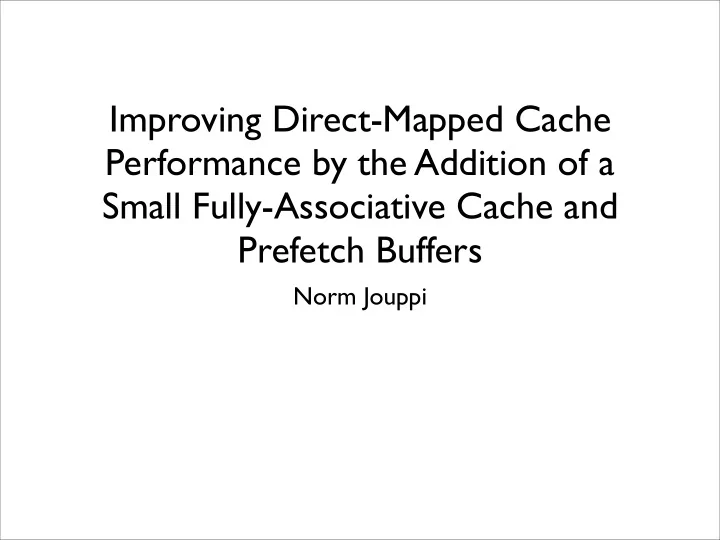

Improving Direct-Mapped Cache Performance by the Addition of a Small Fully-Associative Cache and Prefetch Buffers Norm Jouppi
In Context • At the time, CPU performance was really beginning to pull away from DRAM performance • Increased interest in memory system performance • Mark Hill had just introduced the 4-Cs as way of categorizing cache misses • Conflict • Compulsory • Capacity • Coherence • Single-chip processors were really coming into their own • Increased pressure on area, so direct-mapped caches were very desirable. • It was also before the “Quantitive Approach” 2
Goals • Increase effectiveness of direct-mapped caches without spending much area. • In the retrospective, Norm says he was looking at each class of miss individually. 3
Motivation 4
Idea 1: Miss Buffers • When you fill a line, store a second copy in the miss buffer. • If you need the data again, it’ll be close at hand. 5
Miss Buffer Performance 6
Miss Buffer Gains • The miss buffer only address conflict misses • So it does better when there’s lots of them 7
Problems w/ the Miss Buffer • It wastes space • It’s contents are always replicated in the cache • It needs to be at least two entries to have any benefit. • If the conflicting area is larger than the miss buffer, the miss buffer is of no use. • we should be able to get some benefit from it, since it is extra space • The miss buffer is sort of pessimistic. It assumes that we are going to have a conflict on the data. • Let’s be optimistic. 8
The Victim Cache • Similar to the miss cache, but only put data in the victim cache when there’s actually a miss. 9
Victim Buffer Gains 10
Interesting Metrics 11
Fractional Associativity • Norm mentions the notion of fractional associativity. • You can think of a victim buffer as adding additional associativity to just the lines in the cache that need it. • Why pay for associativity everywhere, when it’s just a few problematic cache lines? 12
Victim Buffers Today • Victim buffers are very popular today, but not as Norm envisioned them. • Associativity is not prohibitively expensive. • In CMPs, cache inclusion makes less sense: • 256KB L2 • 8 cores = 16KB L1 D + I • L1 capacity is equal to L2 capacity • Inclusion is very wasteful -- everything is duplicated • Instead, use the L2 as shared victim buffer • Associative, but not full associative. 13
Address Compulsory and Capacity Misses • Fixing compulsory misses is tough: You must predict the future. • Previous techniques • Larger cache lines • Next line prefetcher 14
Simple Prefetching • Prefetch always • Always bring in the next line on every reference • Seems wasteful. • He says it’s not tractable, but that only applies to this system (maybe) • Prefetch on miss • Seems more reasonable. • Similar to doubling the cache line size • Can reduce misses by half. • Prefetch tagged • When a prefetched block is actually used, the next line is fetched. • Could reduce misses to zero, but waiting for the use is actually too late. • We need to get farther ahead in the access stream. That would require more space. 15
Stream buffers • The previous techniques waste cache space. • perhaps displacing other useful data • A stream buffer provides dedicated space for the prefetched data. 16
Stream Buffers • On a miss, start fetching successive lines • When they return, but them in the stream buffer • On future misses, check the head of the stream buffer, if it’s a hit, great! Fetch another line. • If it’s a miss, clear the stream buffer and start over. 17
Effectiveness • Great for instructions • Ok for data. 18
The problem with data • Programs often make interleaved, sequential streams of accesses • One stream buffer is not enough. • There is only one instruction stream, however. 19
Build Multiple Buffers 20
Stream Buffers today • Prefetching is very popular today • Prefetchers are very sophisticated, and very hard to reverse engineer and/or out-smart. • You need to disable them if you want to measure much of anything about your memory hierarchy. • You will design your own prefetcher later in the course. 21
Conclusions • Victim buffers and stream buffers are worthwhile • They can substantially reduce 3 of the 4 Cs • The paper says very little about how they would perform on a particular machine or how they should be provisioned. • It is all about trends and the underlying characteristics of the access stream that they exploit. • The hardware trade-offs are also important. 22
Recommend
More recommend